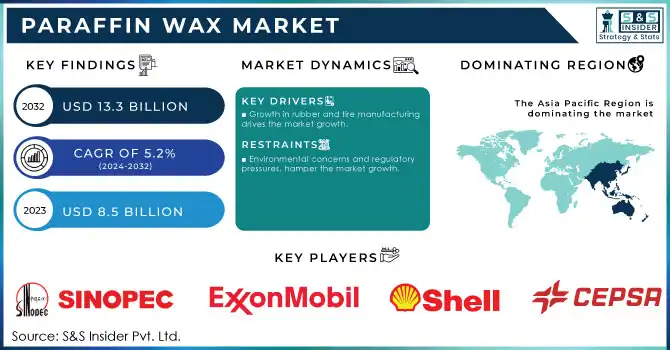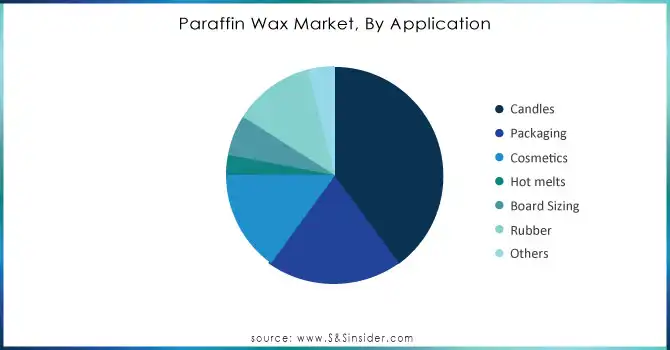Paraffin Wax Market Report Scope & Overview:

Get More Information on Paraffin Wax Market - Request Sample Report
The Paraffin Wax Market Size was valued at USD 8.5 Billion in 2023. It is expected to grow to USD 13.3 Billion by 2032 and grow at a CAGR of 5.2% over the forecast period of 2024-2032.
The demand for paraffin wax has witnessed substantial growth, especially in the packaging industry, which is being significantly influenced by sustainability and the expansion of global trade. While several industries have pivoted towards more environmentally friendly approaches to their products, paraffin wax is being adopted in developments for recyclable and biodegradable packaging materials due to its water resistance and barrier properties. This inclination towards sustainable packaging is a reaction to the growing environmental concerns and regulatory pressure over plastic waste. Moreover, the expansion of global trade due to the boom in e-commerce and international trade activity has also contributed to the increasing demand for paraffin-wax-coated packing, especially for the food and beverage industry. The increasingly interconnected global market needs decent quality delivery of paraffin wax is effective in defending the freshness of merchandise with coating as an outer layer, which enhances the shelf life and contrasting quality while traveling.
The International Trade Administration (ITA) highlights that the U.S. alone exported over USD 152 billion worth of food products in 2022, many of which rely on packaging materials that include paraffin wax for preserving freshness and extending shelf life during international shipping.
The increasing demand for candles, especially paraffin wax, is primarily due to their low cost, their multifunctionality, and the optimal retention of fragrance and color. The use of candles is mainly a decorative purpose but also has therapeutic benefits which is becoming popular more than ever such as in aromatherapy. With the growing use of candles for relaxation and the atmosphere found in home wellness regimes, the demand for high-quality paraffin wax candles keeps increasing. Moreover, the rising number of celebration events around the world, including festivals, weddings, and vacations, is also driving the demand for candles. Whilst classic merchandising segments remain strong, the Asia-Pacific and Middle East markets for candles are growing rapidly.
The United Nations (UN) estimates that by 2030, almost 60% of the world’s population will live in urban areas, with substantial growth in urban populations in Asia and the Middle East. This urbanization trend is expected to increase consumer spending on home-related products like candles, as people invest in home décor and wellness products.
Paraffin Wax Market Dynamics
Drivers
-
Growth in rubber and tire manufacturing drives the market growth.
Manufacturing of rubber and tire is one of the major applications of paraffin wax, thus bolstering adopting other applications is projected to grow, thereby driving demand for paraffin wax. Used in rubber processing, paraffin wax enhances rubber product properties such as those of tire rubbers. It is a protective layer that helps to resist surface cracking, oxidation, and degradation of rubber therefore prolonging the service life of rubber components. In tire production, paraffin wax is especially useful because it facilitates the manufacturing process, keeps them from sticking during production, and adds a smooth finish to the tires. With car ownership and the overall manufacture of automobiles growing in emerging markets, the pressure for tires on a global basis mount with it. An increase in tire usage leads to the demand for paraffin wax used in the tire manufacturing process. In addition, the rebound of the automotive industry from the pandemic, along with advancements in electric vehicle (EV) tire technologies, and increased vehicle production across nations such as China, India, and the U.S., are also anticipated to provide an uptick to the demand for paraffin wax in rubber and tire applications.
The U.S. Department of Energy (DOE) highlighted that the electric vehicle market in the U.S. grew by 65% in 2022, reaching more than 800,000 EVs sold. This growth in EVs is influencing tire manufacturing, as these vehicles require specialized tires.
Restraint
-
Environmental concerns and regulatory pressures. hamper the market growth.
Paraffin Wax market dynamics environmental concerns and regulatory pressures play a major restraining factor for the growth of the paraffin wax market. With growing consciousness towards environmental issues, several governments are enforcing stringent regulations to minimize the use of petrochemical products. The European Green Deal as well as targets to reduce carbon emissions have been prompting industries to transition toward greener and more sustainable alternatives. This has resulted in rising requirements for bio-based waxes such as soy and beeswax, both of which are renewable, biodegradable, and environmentally friendly. Also, consumers are increasingly awareness of the sustainability of the products they buy which encourages the country to shift to buying products that have a renewable source. As such, long-term market growth is now threatened for paraffin wax unless the industry can develop more commercially viable production processes that comply with the expanding range of environmental regulations coupled with a growing producer emphasis on alternative carbon neutral or sustainable production methods or increasingly more environmentally sound consumer preferences in many markets worldwide.
Paraffin Wax Market Segmentation Overview
By Application
Candle held the largest market share around 62% in 2023. It is owing to their extensive use for decorative, ceremonial, and functional uses. The material most used in the manufacture of candles is paraffin wax, which is inexpensive, easy to handle, and has great combustion properties. Other than that, because it retains fragrance and holds color well, it is good for use in scented and decorative candles, which are popular for atmosphere, relaxation, and therapeutic applications such as aromatherapy. Moreover, the increasing trend of using candles in home décor, wellness traditions, and celebratory occasions has catapulted the demand for paraffin wax. In 2023, self-care is the global norm, and candle-making is inextricably linked with that trend; thus, the prevalence and cheap production of paraffin wax have ensured its place at the top of the candle-making chain. While candles are increasingly becoming a part of households across the world, the market share is led by paraffin wax-based candles, which ultimately remain the primary material used in the production.

Need Any Customization Research On Paraffin Wax Market - Inquiry Now
Paraffin Wax Market Regional Analysis
Asia Pacific held the largest market share around 62% in 2023. Owing to high industrialization, growing consumer demands, and high production in manufacturing industries Paraffin wax is used in various applications such as for candles, packaging, cosmetics, and rubber manufacturing, whereas the growing economies of the region especially in countries such as China, India, and Japan are fueling the increasing demand for paraffin wax. As the largest global consumer and producer of paraffin wax, China is a major driver of the regional market. Furthermore, an expanding middle class and disposable income in the region are also boosting the consumption of paraffin wax used in consumer goods such as candles, cosmetics, and packaged food. The strong manufacturing base in Asia Pacific also creates a continuous growth for paraffin wax amongst industrial applications such as coatings and lubricants. In addition, increasing urbanization, infrastructural development, and the growing E-commerce sector within this region further drive the paraffin wax-coated products market demand for packaging materials.

Key Players in Paraffin Wax Market
-
Sinopec (Fully Refined Paraffin Wax, Semi-Refined Paraffin Wax)
-
ExxonMobil (Microcrystalline Wax, ParaPro High Melting Wax)
-
Royal Dutch Shell PLC (Shellwax S100, Shellwax T32)
-
CEPSA (Cerasur Fully Refined Wax, Cerasur Micro Wax)
-
Petrobras (Paraffin Wax Type A, Type B Wax)
-
Calumet Specialty Products Partners (Bulk Paraffin Wax, Packaged Paraffin Wax)
-
PetroChina Company Limited (Hydrogenated Wax, Semi-Refined Wax)
-
ENEOS Corporation (Fully Refined Wax, Melt Wax 120)
-
Sasol Limited (Fischer-Tropsch Wax, Paraffin Wax)
-
HollyFrontier Corporation (Multiwax 180-M, Multiwax 445)
-
Evonik Industries (Viscosoft Wax, Dynasole Wax)
-
International Group Inc. (IGI) (IGI 1260A, IGI 4627A)
-
Honeywell International (Micronized Paraffin Wax, Micronized Polyethylene Wax)
-
Nippon Seiro Co., Ltd. (Hard Paraffin Wax, Semi-Refined Wax)
-
Trecora Resources (Pentane Blended Wax, Wax Blend 145)
-
Apar Industries Ltd. (Industrial Wax, Decorative Wax)
-
H&R Group (CeraPol Paraffin Wax, Multi-functional Wax)
-
Lukoil (Fully Refined Wax, Special Grade Wax)
-
Panama Petrochem (Slack Wax, Rubber Process Oil Wax)
-
TotalEnergies SE (Paraffin Wax N60, Total Wax 90)
Recent Development:
-
In 2023, ExxonMobil expanded its paraffin wax production capacity with a new plant in Asia to meet the growing demand for high-quality waxes used in candles, packaging, and cosmetics.
-
In 2023, Sasol, company, announced the development of a new bio-based paraffin wax variant derived from renewable resources. This product is aimed at addressing growing consumer demand for more sustainable and eco-friendly alternatives to traditional petroleum-based waxes.
-
In 2022, Shell Chemicals introduced new advancements in paraffin wax technology designed to improve the product's environmental footprint. The company focused on increasing the efficiency of its production processes to reduce emissions and enhance the quality of its paraffin wax offerings.
| Report Attributes | Details |
|---|---|
| Market Size in 2023 | US$ 8.5 Billion |
| Market Size by 2032 | US$ 13.3 Billion |
| CAGR | CAGR of5.2% From 2024 to 2032 |
| Base Year | 2023 |
| Forecast Period | 2024-2032 |
| Historical Data | 2020-2022 |
| Report Scope & Coverage | Market Size, Segments Analysis, Competitive Landscape, Regional Analysis, DROC & SWOT Analysis, Forecast Outlook |
| Key Segments | • By Application (Candles, Packaging, Cosmetics, Hot Melts, Board Sizing, Rubber, Others) |
| Regional Analysis/Coverage | North America (US, Canada, Mexico), Europe (Eastern Europe [Poland, Romania, Hungary, Turkey, Rest of Eastern Europe] Western Europe [Germany, France, UK, Italy, Spain, Netherlands, Switzerland, Austria, Rest of Western Europe]), Asia Pacific (China, India, Japan, South Korea, Vietnam, Singapore, Australia, Rest of Asia Pacific), Middle East & Africa (Middle East [UAE, Egypt, Saudi Arabia, Qatar, Rest of Middle East], Africa [Nigeria, South Africa, Rest of Africa], Latin America (Brazil, Argentina, Colombia, Rest of Latin America) |
| Company Profiles | Sinopec, ExxonMobil, Royal Dutch Shell PLC, CEPSA, Petrobras, Calumet Specialty Products Partners, PetroChina Company Limited, ENEOS Corporation, Sasol Limited, HollyFrontier Corporation, Evonik Industries, International Group Inc. (IGI), Honeywell International, Nippon Seiro Co., Ltd., Trecora Resources, Apar Industries Ltd., H&R Group, Lukoil, Panama Petrochem, TotalEnergies SE.and Others |
| Key Drivers | • Growth in rubber and tire manufacturing drives the market growth. |
| RESTRAINTS | • Environmental concerns and regulatory pressures. hamper the market growth. |

